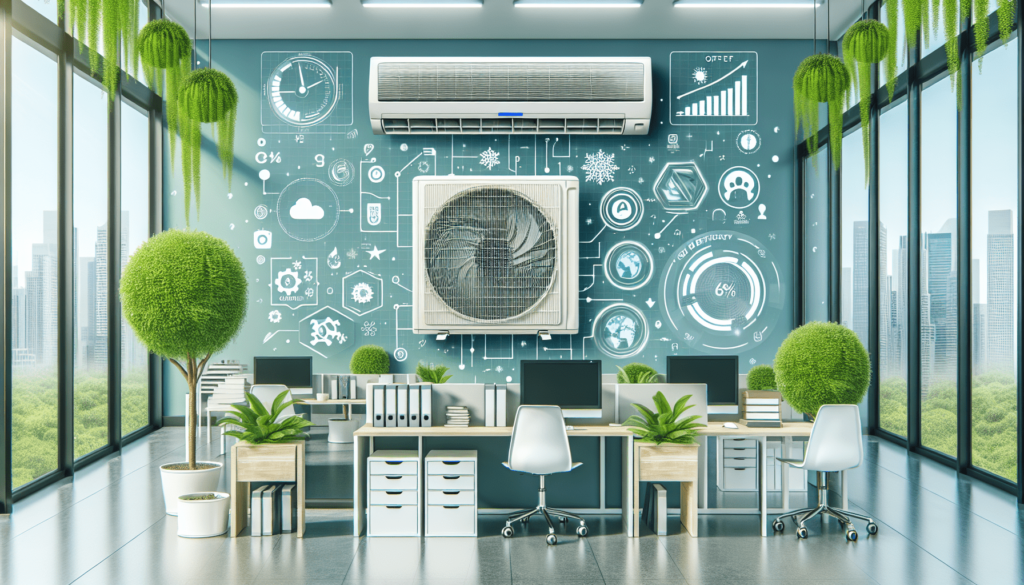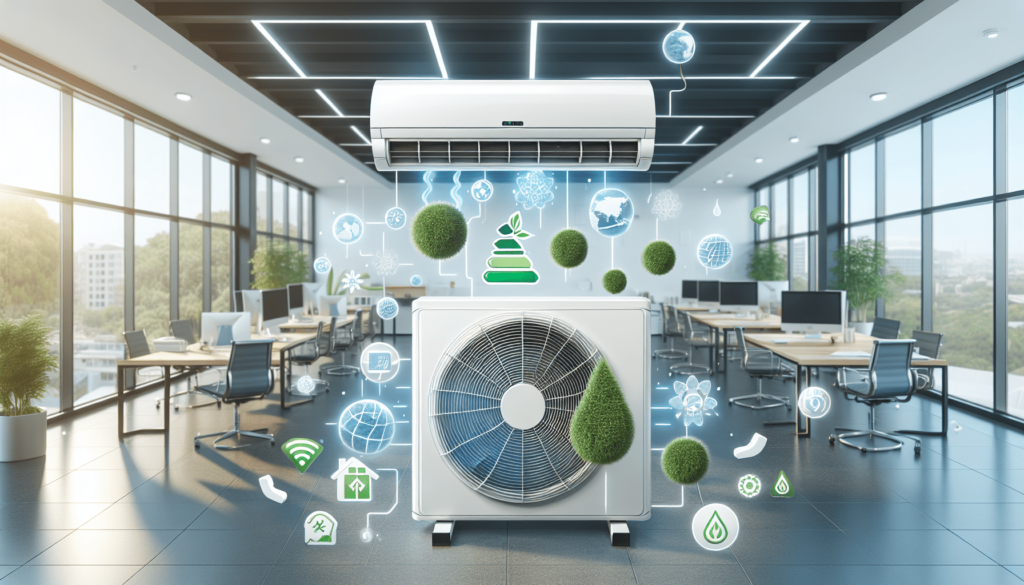In today’s rapidly changing climate, it is imperative for businesses to consider the environmental impact of their operations. One area that often goes overlooked is the cooling systems used in office spaces. Mini split AC systems have gained popularity due to their efficiency and versatility. However, their impact on the environment is a topic that requires careful examination. This article explores the environmental implications of using mini split AC systems for office cooling, shedding light on their energy consumption, refrigerant usage, and overall carbon footprint. By understanding the environmental consequences, businesses can make informed decisions to minimize their ecological footprint and contribute to a sustainable future.

This image is property of pixabay.com.
Understanding Mini Split AC Systems
Definition of Mini Split AC Systems
A mini split air conditioning (AC) system, also known as a ductless system, is an innovative cooling technology that provides efficient and customizable indoor climate control. Unlike traditional AC systems that rely on ductwork to distribute cooled air, mini split AC systems consist of two main components: an outdoor unit, which houses the compressor and condenser, and one or more indoor units, which deliver cooled air directly into specific areas or rooms.
Components of a Mini Split AC System
A mini split AC system comprises several key components that work together to provide effective cooling. These components include the outdoor unit, the indoor unit(s), refrigerant lines, and a remote control or thermostat for temperature adjustments. The outdoor unit contains the compressor, which compresses and circulates the refrigerant, and the condenser, which releases heat from the refrigerant. The indoor unit(s) consist of an evaporator coil that cools and dehumidifies the air, a fan that circulates the cooled air, and a filter that helps improve air quality.
How Mini Split AC Systems Work
Mini split AC systems operate based on the principle of refrigeration. The outdoor unit houses the compressor, which compresses the refrigerant and raises its temperature. The heated refrigerant then flows through the refrigerant lines to the indoor unit(s), where it enters the evaporator coil. Inside the evaporator coil, the refrigerant expands and evaporates, absorbing heat from the indoor air and cooling it in the process. The cooled air is then circulated back into the room by the fan in the indoor unit(s), while the refrigerant, now in a gaseous state, returns to the outdoor unit to be compressed and heated again.
Energy Efficiency of Mini Split AC Systems
Comparison of Energy Efficiency Between Mini Split AC Systems and Traditional AC Systems
Mini split AC systems are renowned for their superior energy efficiency compared to traditional AC systems. The absence of ductwork in mini split systems eliminates the energy losses that typically occur in ducted systems. Additionally, mini split AC systems utilize inverter technology, which allows the compressor to adjust its speed based on the cooling demand, resulting in significant energy savings.
Role of Inverter Technology in Improving Energy Efficiency
Inverter technology plays a crucial role in enhancing the energy efficiency of mini split AC systems. Unlike traditional AC systems that constantly turn off and on to maintain the desired temperature, mini split AC systems with inverter technology continuously adjust the compressor speed to match the cooling load. This eliminates energy wastage during start-up and reduces frequent on/off cycling, resulting in more efficient operation and lower energy consumption.
Effect of Energy Efficiency on Environment
The energy efficiency of mini split AC systems has a positive impact on the environment. By consuming less energy, these systems reduce the demand for electricity, leading to decreased reliance on fossil fuel-based power generation. This, in turn, helps to mitigate greenhouse gas emissions, air pollution, and the depletion of natural resources. Furthermore, improved energy efficiency contributes to the overall sustainability of a building or office space, aligning with global efforts to combat climate change.
Reduced Carbon Dioxide Emissions
Contribution of AC Systems to Carbon Dioxide Emissions
Air conditioning systems, including both mini split and traditional AC systems, contribute to carbon dioxide (CO2) emissions. The generation of electricity to power these systems often relies on fossil fuel combustion, which releases CO2 into the atmosphere. The more energy-efficient a cooling system is, the lower the associated CO2 emissions.
How Mini Split AC Systems Reduce Carbon Dioxide Emissions
Mini split AC systems significantly reduce carbon dioxide emissions compared to traditional AC systems. Their energy-efficient operation and use of inverter technology consume less electricity, resulting in a reduced demand for power generation. This decrease in electricity consumption leads to fewer CO2 emissions associated with electricity production, thus contributing to a more sustainable and climate-friendly cooling solution.
Impact of Reduced Carbon Dioxide Emissions on Environment
The reduction in carbon dioxide emissions achieved by using mini split AC systems has a positive environmental impact. CO2 emissions are a major contributor to climate change and global warming, as they trap heat in the Earth’s atmosphere. By minimizing CO2 emissions through the adoption of energy-efficient technologies like mini split AC systems, we can help mitigate the negative effects of climate change, such as rising temperatures, extreme weather events, and sea-level rise.
Mini Split AC Systems and the Ozone Layer
Role of AC Systems in Ozone Layer Depletion
Traditional AC systems, particularly those that use hydrochlorofluorocarbons (HCFCs) or chlorofluorocarbons (CFCs) as refrigerants, pose a significant threat to the ozone layer. These refrigerants contain chlorine, which, when released into the atmosphere, reacts with ozone molecules and depletes the ozone layer. The depletion of the ozone layer contributes to a variety of environmental issues, including increased UV radiation reaching the Earth’s surface.
How Mini Split AC Systems Protect the Ozone Layer
Mini split AC systems utilize more environmentally friendly refrigerants, such as hydrofluorocarbons (HFCs) or hydrofluoroolefins (HFOs), which have zero or minimal ozone depletion potential. By eliminating the use of ozone-depleting substances, mini split AC systems help protect the ozone layer and contribute to the preservation of a healthy and sustainable environment.
Implications for Global Warming and Climate Change
The protection of the ozone layer through the use of mini split AC systems also helps in the fight against global warming and climate change. Ozone-depleting substances, such as HCFCs and CFCs, are also potent greenhouse gases that trap heat in the atmosphere, leading to global warming. By preventing their release, mini split AC systems play a crucial role in reducing greenhouse gas emissions and promoting a more sustainable and climate-friendly society.

This image is property of pixabay.com.
Waste Reduction in Mini Split AC Systems
Waste Generation in Traditional AC Systems
Traditional AC systems are associated with significant waste generation throughout their lifecycle. The installation of ductwork in buildings often requires extensive construction, resulting in the production of construction waste. Additionally, the maintenance and replacement of traditional AC systems frequently involve the disposal of old, bulky equipment, adding to the waste load.
How Mini Split AC Systems Limit Waste
Mini split AC systems contribute to waste reduction through several aspects of their design and operation. Firstly, the absence of ductwork in these systems eliminates the need for extensive construction, reducing the amount of construction waste generated during installation. Secondly, mini split AC systems are typically smaller and more compact than traditional systems, resulting in less material waste during manufacturing and disposal. Lastly, the modular design of mini split AC systems allows for easier maintenance and component replacement, minimizing the amount of equipment that needs to be discarded.
Implications for Landfills and Waste Management
The waste reduction achieved by mini split AC systems has implications for landfills and waste management. By minimizing waste generation, these systems alleviate the burden on landfills and reduce the environmental impacts associated with waste disposal. Additionally, the more efficient use of resources and the reduced demand for new equipment in mini split AC systems contribute to sustainable waste management practices and the conservation of valuable resources.
Water Conservation and Mini Split AC Systems
Water Use in Traditional AC Systems
Traditional AC systems often require the use of water for cooling purposes. Water-cooled condensers or cooling towers are common components in these systems and consume significant amounts of water during operation. The water used in traditional AC systems poses challenges in terms of water scarcity and the management of wastewater.
How Mini Split AC Systems Save Water
Mini split AC systems offer a more water-efficient alternative to traditional AC systems. These systems rely on air-cooled condensers, eliminating the need for water consumption in the cooling process. By avoiding the use of water, mini split AC systems contribute to water conservation efforts and reduce the strain on already limited water resources.
Impact on Water Scarcity and Conservation Efforts
The water-saving capabilities of mini split AC systems have a positive impact on water scarcity and conservation efforts, particularly in regions experiencing water stress or facing limited access to clean water. By minimizing water consumption, these systems help conserve water resources, reduce the strain on freshwater ecosystems, and promote sustainable water management practices. Additionally, the reduction in wastewater generation associated with water-cooled systems contributes to minimizing pollution and protecting water quality.

This image is property of pixabay.com.
Smart Cooling and Temperature Control
Benefits of Precise Temperature Control
Precise temperature control is a key advantage of mini split AC systems. By offering individual temperature control in different areas or rooms, these systems allow for optimal comfort and customization. This precise temperature control ensures that cooling is only provided where needed, reducing energy wastage and promoting efficient use of resources.
How Mini Split AC Systems Promote Smart Cooling
Mini split AC systems promote smart cooling through their ability to provide zoned temperature control. Zoning allows for the independent adjustment of temperatures in different spaces, optimizing comfort while avoiding unnecessary cooling. By adapting to specific cooling demands, mini split AC systems reduce energy consumption and improve overall efficiency.
Implications for Energy Consumption and Environmental Impact
The emphasis on smart cooling and precise temperature control in mini split AC systems has significant implications for energy consumption and the environmental impact of cooling. By avoiding unnecessary cooling of unoccupied or less frequently used areas, these systems reduce energy waste and decrease the associated environmental footprint. The ability to customize temperature settings also promotes energy conservation and supports sustainable energy management practices.
Mini Split AC Systems and Indoor Air Quality
Relationship Between Air Conditioning and Indoor Air Quality
Air conditioning systems play a crucial role in maintaining and improving indoor air quality. By cooling and dehumidifying the air, AC systems help control moisture levels, reduce the growth of mold and bacteria, and filter out airborne particles, pollutants, and allergens. As a result, proper air conditioning contributes to a healthier and more comfortable indoor environment.
How Mini Split AC Systems Improve Indoor Air Quality
Mini split AC systems excel in improving indoor air quality due to several factors. Firstly, the use of filters in the indoor units helps trap and remove airborne particles and allergens, enhancing the overall air cleanliness. Additionally, mini split AC systems do not rely on ductwork, which can accumulate dust, mold, and other contaminants, potentially compromising indoor air quality. By eliminating ductwork, mini split AC systems reduce the risk of air pollution and the circulation of contaminants throughout the building.
Effect on Health and Well-being
The improvement of indoor air quality achieved by mini split AC systems has significant implications for health and well-being. Better air quality reduces exposure to allergens and pollutants, promoting respiratory health and reducing the risk of respiratory conditions such as asthma or allergies. Additionally, the control of humidity levels by mini split AC systems helps prevent the growth of mold and mildew, which can have detrimental effects on both physical health and indoor environmental quality.

Life Span and Durability of Mini Split AC Systems
Comparing Life Span of Mini Split and Traditional AC Systems
Mini split AC systems are known for their longer life span compared to traditional AC systems. While traditional systems typically last around 15-20 years, mini split systems can often exceed 20 years when properly maintained. The increased durability and longevity of mini split AC systems contribute to minimizing the environmental impact associated with frequent equipment replacement.
Importance of Durability in Reducing Environmental Impact
The durability of mini split AC systems is a key factor in reducing their overall environmental impact. A longer life span means less frequent replacement, leading to reduced waste generation and resource consumption. By investing in durable cooling systems like mini splits, businesses and individuals can lower their environmental footprint and promote sustainable consumption, aligning with the principles of a circular economy.
Impact on Resource Consumption and Waste Generation
The extended life span of mini split AC systems has positive implications for resource consumption and waste generation. By lasting longer, these systems reduce the need for new equipment and the associated extraction of raw materials. This, in turn, minimizes the waste generated from disposing of old cooling units. The longer service life of mini split AC systems contributes to resource conservation and sustainable waste management practices.
Challenges and Solutions in Implementing Mini Split AC Systems
Common Challenges in Upgrading to Mini Split AC Systems
While mini split AC systems offer numerous benefits, their implementation may pose certain challenges. One challenge is the initial cost, as mini split systems can have a higher upfront investment compared to traditional AC systems. Additionally, retrofitting existing buildings or offices with mini split systems may require modifications to the existing electrical infrastructure, which can add to the installation complexity and cost.
Potential Solutions and Strategies
To overcome the challenges in implementing mini split AC systems, certain solutions and strategies can be employed. Evaluating the long-term cost savings from energy efficiency and reduced maintenance expenses can help justify the initial investment. Working closely with experienced HVAC professionals during the design and installation phases can ensure the proper integration of mini split systems into existing buildings. Conducting a thorough analysis of the building’s cooling requirements and energy consumption patterns can help determine the optimal system size and minimize unnecessary costs.
Considerations for Office Buildings and Commercial Spaces
When implementing mini split AC systems in office buildings and commercial spaces, several considerations should be taken into account. The zoning capabilities of mini split systems allow for customized temperature control in different rooms or areas, creating a comfortable environment for employees and customers. The compact size of these systems also enables more flexible installation options, making them suitable for spaces with limited available space. Furthermore, the energy efficiency and durability of mini split AC systems can result in significant cost savings and improved sustainability in commercial settings, aligning with the increasing emphasis on green building practices.


